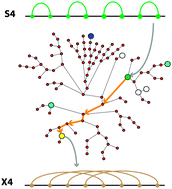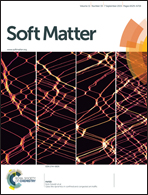Distance measures and evolution of polymer chains in their topological space†
Abstract
Conformational transitions are ubiquitous in biomolecular systems, have significant functional roles and are subject to evolutionary pressures. Here we provide a first theoretical framework for topological transition, i.e. conformational transitions that are associated with changes in molecular topology. For folded linear biomolecules, arrangement of intramolecular contacts is identified as a key topological property, termed as circuit topology. Distance measures are proposed as reaction coordinates to represent progress along a pathway from initial topology to final topology. Certain topological classes are shown to be more accessible from a random topology. We study dynamic stability and pathway degeneracy associated with a topological reaction and found that off-pathways might seriously hamper evolution to desired topologies. Finally we present an algorithm for estimating the number of intermediate topologies visited during a topological reaction. The results of this study are relevant to, among others, structural studies of RNA and proteins, analysis of topologically associated domains in chromosomes, and molecular evolution.


 Please wait while we load your content...
Please wait while we load your content...